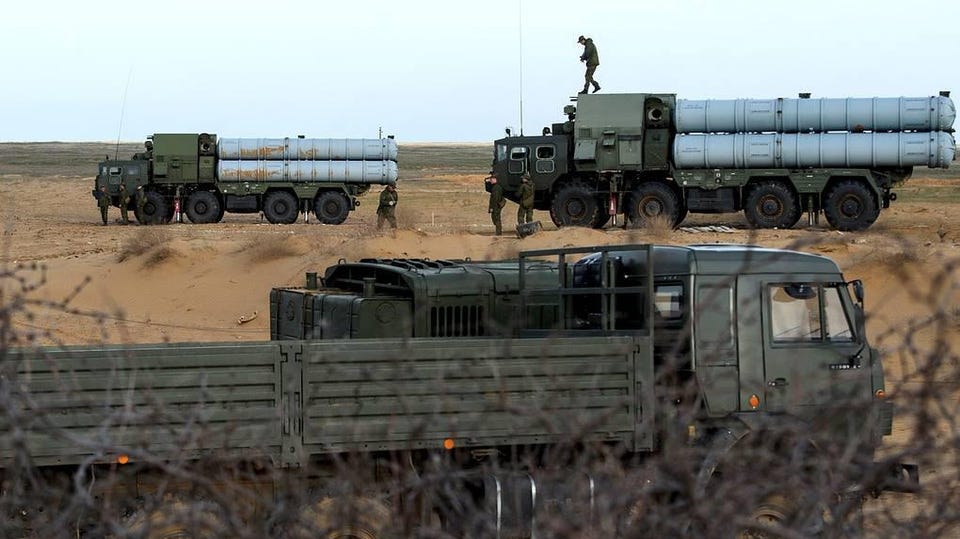Aerospace & Defense Desperate Russian Troops Apparently Lobbed Anti-Air Missiles At Ukrainian Targets On Land David Axe Forbes Staff I write about ships, planes, tanks, drones, missiles and satellites. New! Follow this author to improve your content experience. Got it! Jul 11, 2022, 08:00am EDT | Share to Facebook Share to Twitter Share to Linkedin Russian S-300s.
Russian state media photo Russian forces in Ukraine reportedly have fired S-300 anti-aircraft missiles at Ukrainian targets . . .
on the ground. If true, that’s yet more evidence of a worsening problem for the Russian army as the wider war in Ukraine grinds toward its fifth month. The Russians are running out of precision munitions for long-range strikes.
Vitaliy Kim, the Ukrainian administrator of Mykolaiv Oblast in southern Ukraine, first reported the S-300 strikes. The Russians launched six S-300s that landed in a garden in the oblast, Kim wrote on social media on Saturday. “Saint Nicholas protects us,” he wrote .
“No casualties. ” It’s not unusual for spent surface-to-air missiles to wind up in gardens, fields or cities. What goes up must come down, after all.
But the Ukrainian armed forces’ southern command specified that the Russians deliberately were using the S-300s in a land-attack role. If true, that’s . .
. less than optimal. S-300 batteries fire 25-foot missiles with smallish, 300-pound warheads and radar fuzes that work perfectly well against flimsy aluminum aircraft—but not so well against steel-built ground vehicles or concrete buildings.
Guidance also is an issue. Some S-300 batteries fire missiles with “semi-active” radar guidance, meaning the missiles follow signals from a radar on the ground. Others fire missiles with their own, “active” radar guidance.
MORE FOR YOU American Airlines Pilots Say Operations Managers Must Go After Summer Breakdowns The U. S. Air Force Is Gradually Rebuilding Its B-52 Bombers From The Rivets Out An American Bomber Visited Malaysia.
A Bizarre Mix Of Local Jets Rose To Meet It. Neither guidance type would work very well against structures. And not at all against moving ground targets such as vehicles.
To be clear, there are SAMs with an effective land-attack mode— the U. S. Navy’s SM-6, for example —but the word “mode” is operative.
It’s one thing to design a missile with a seeker and warhead that work equally well against targets in the air and on the surface. It’s quite another to fling a missile with one effective mode—air to air—at a target on the ground. It smacks of desperation.
As though the Russians in southern Ukraine lacked any other means of bombarding Mykolaiv from inside their own lines, 50 or so miles to the south. It’s apparent Russian forces are running low on long-range, precision munitions. More and more, we’re seeing the Russians use, for land-attack, missiles that weren’t really meant for land-attack.
And not just S-300s. The Russian navy has been firing Bastion anti-ship missiles at Ukrainian ground troops. The Russian air force recently struck a Ukrainian shopping mall with a Kh-32 missile whose intended role is sinking American aircraft carriers.
“It is . . .
not optimized to accurately strike ground targets, especially in an urban environment,” the U. K. Defense Ministry stated with regard to the Kh-32.
“This greatly increases the likelihood of collateral damage when targeting built-up areas. ” U. S.
officials anticipated the apparent Russian missile shortage. “We do assess that they are running through their precision-guided missiles at a pretty fast clip,” Pentagon spokesperson John Kirby told reporters on May 10. Russia can’t easily replace the 2,000 or so precision missiles its forces have fired at Ukraine in more than four months of intensive warfare.
Missiles are expensive and take time to produce. More troubling for Russia, they require sophisticated electronics and compact engines, which Russia tends to import owing to its own industry’s lack of expertise and quality-control. Ironically, Russia used to get its small missile motors .
. . from Ukraine.
Foreign sanctions, which have tightened since Russia attacked Ukraine in late February, largely have blocked the export to Russia of whole classes of missile components, severely curtailing Russian production. “In total, Russia can manufacture no more than 225 cruise and tactical ballistic missiles a year,” wrote Pavel Luzin, an independent expert on the Russian military. At that rate, Russia would have to maximize production for a decade— and stop firing additional missiles—in order to restock its arsenal.
The alternative, of course, is to continue mismatching munitions and targets. Shooting anti-ship missiles at tanks. Anti-air missiles at buildings.
Sure, they’re likely to miss. Yes, there’s greater risk to civilians in the area. It’s not clear the Kremlin is all that worried about the imprecision.
Follow me on Twitter . Check out my website or some of my other work here . Send me a secure tip .
David Axe Editorial Standards Print Reprints & Permissions.
From: forbes
URL: https://www.forbes.com/sites/davidaxe/2022/07/11/desperate-russian-troops-apparently-lobbed-anti-air-missiles-at-ukrainian-targets-on-land/



